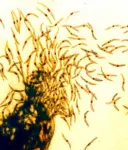New beetle found in fossil feces attributed to dinosaur ancestor
2021-06-30
(Press-News.org) The tiny beetle Triamyxa coprolithica is the first-ever insect to be described from fossil faeces. The animal the researchers have to thank for the excellent preservation was probably the dinosaur ancestor Silesaurus opolensis, which 230 million years ago ingested the small beetle in large numbers.
In a recently published study in Current Biology, vertebrate palaeontologists from Uppsala University and entomologists from National Sun Yat-sen University (Taiwan), Friedrich-Schiller-Universität Jena (Germany), and Universidad de Guadalajara (Mexico) used synchrotron microtomography to 3D-reconstruct the beetles while they were still trapped within the fossilised faecal matter. The coprolite contained abundant beetle body parts, most belonging to the same small species. A few specimens were found nearly complete, with much of the delicate legs and antennae still intact. The well-preserved state of these fossils made it possible to produce a detailed description of the new beetle genus and to compare it with more modern ones. Triamyxa coprolithica represents a previously unknown extinct lineage of the suborder Myxophaga, whose modern representatives are small and live on algae in wet environments.
"We were absolutely amazed by the abundance and fantastic preservation of the beetles in the coprolite fragment. In a way, we must really thank Silesaurus, which likely was the animal that helped us accumulating them," says Martin Qvarnström, researcher at Uppsala University and one of the co-authors of the paper.
Silesaurus opolensis - the probable producer of the coprolite - was a relatively small dinosaur ancestor with an estimated body weight of 15 kilograms that lived in Poland approximately 230 million years ago. In a previous study, the authors assigned coprolites with disarticulated beetle remains to Silesaurus based on the size and shape of the coprolites as well as several anatomical adaptations in the animal. Silesaurus possessed a beak at the tip of its jaws that could have been used to root in the litter and perhaps peck insects off the ground, somewhat like modern birds. But although Silesaurus ingested numerous individuals of Triamyxa coprolithica, the beetle was likely too small to have been the only targeted prey. Instead, Triamyxa likely shared a habitat with larger beetles, which are represented by disarticulated remains in the coprolites, and other prey, which never ended up in the coprolites in a recognisable shape.
"I never thought that we would be able to find out what the Triassic precursor of the dinosaurs ate for dinner," says Grzegorz Nied?wiedzki, palaeontologist at Uppsala University and one of the co-authors of the paper.
The preservation of the beetles in the coprolite is similar to specimens from amber, which normally yield the best-preserved insect fossils. Amber, however, was mainly formed during relatively recent geological time. This study shows that coprolites may be valuable for studying early insect evolution and, at the same time, the diet of extinct vertebrates.
The synchrotron scanning was carried out at the European Synchrotron Radiation Facility (ESRF) in Grenoble.
INFORMATION:
[Attachments] See images for this press release:

ELSE PRESS RELEASES FROM THIS DATE:
2021-06-30
Harpy eagles (Harpia harpyja) - which are among the world's largest eagle species - struggle to feed offspring in heavily deforested areas of the Amazon, according to a study published in Scientific Reports.
Everton Miranda and colleagues found that harpy eagles rely on specific prey that lives in canopy forests, including sloths and monkeys. Eaglets starved in areas of high deforestation where canopy-based food was limited.
The authors observed prey species, how frequently prey was delivered, and estimated the weight of prey in 16 harpy eagle nests in Amazonian forests in Mato ...
2021-06-30
ROCKVILLE, MD, USA - June 30, 2021 - Researchers from Sanaria® Inc. and the National Institutes of Health (NIH) are making progress in the development of highly protective malaria vaccines.
In an article published today in Nature, Sanaria's PfSPZ-CVac (CQ) vaccine is reported as being safe and protecting 100% of six subjects against a variant malaria parasite three months after their last dose in the company's Phase 1 safety and efficacy trial. This is the first time complete protection against a variant malaria parasite has ever been achieved that long after vaccine administration.
The ...
2021-06-30
Many neurodevelopmental disorders share similar symptoms, such as learning disabilities or attention deficits. A new study from MIT has uncovered a common neural mechanism for a type of cognitive impairment seen in some people with autism and schizophrenia, even though the genetic variations that produce the impairments are different for each condition.
In a study of mice, the researchers found that certain genes that are mutated or missing in some people with those disorders cause similar dysfunctions in a neural circuit in the thalamus. If scientists could develop drugs that target this circuit, they could be used to treat people who have different disorders with common behavioral ...
2021-06-30
In 1934, physicist Eugene Wigner made a theoretical prediction based on quantum mechanics that for 87 years went unseen.
The theory suggested how a metal that normally conducts electricity could turn into a nonconducting insulator when the density of electrons is reduced. Wigner theorized that when electrons in metals are brought to ultracold temperatures, these electrons would be frozen in their tracks and form a rigid, non-electricity conducting structure -- a crystal -- instead of zipping around at thousands of kilometers per second and creating an electric current. Since he discovered it, the ...
2021-06-30
Researchers have found that eating disorder behaviors, such as binge-eating, alter the brain's reward response process and food intake control circuitry, which can reinforce these behaviors. Understanding how eating disorder behaviors and neurobiology interact can shed light on why these disorders often become chronic and could aid in the future development of treatments. The study, published in JAMA Psychiatry, was supported by the National Institutes of Health.
"This work is significant because it links biological and behavioral factors that interact to adversely impact eating behaviors," said Janani Prabhakar, ...
2021-06-30
Neuroscientists at UCL have, for the first time, identified abnormalities in the way memories are 'replayed' in the brains of people with schizophrenia; researchers say the pathbreaking study provides an entirely new basis for explaining many of the condition's core symptoms.
Schizophrenia is a serious and debilitating mental disorder characterised by episodes of psychosis. Symptoms include hallucinations (typically hearing voices), delusions, and disorganised thinking. It affects around 20 million people globally, though the exact cause is unknown.
In the study, published in the journal Cell, researchers used state-of-the-art ...
2021-06-30
A new study by investigators from Brigham and Women's Hospital examines the associations between wealth mobility and long-term cardiovascular health. The multidisciplinary study borrowed methodology from the field of economics to analyze longitudinal changes in wealth. The team's results indicate that negative wealth mobility is associated with an increased risk of cardiovascular events, while positive wealth changes are associated with a decreased risk of cardiovascular events. Their results are published in END ...
2021-06-30
WHAT:
Two U.S. Phase 1 clinical trials of a novel candidate malaria vaccine have found that the regimen conferred unprecedentedly high levels of durable protection when volunteers were later exposed to disease-causing malaria parasites. The vaccine combines live parasites with either of two widely used antimalarial drugs--an approach termed chemoprophylaxis vaccination. A Phase 2 clinical trial of the vaccine is now underway in Mali, a malaria-endemic country. If the approach proves successful there, chemoprophylaxis vaccination, or CVac, potentially could help reverse the stalled decline of global malaria. Currently, there is no vaccine in widespread use ...
2021-06-30
What The Study Did: This crossover trial found that perceived breathing resistance at peak exercise is uniquely and significantly elevated when exercise stress testing (EST) is performed while wearing a mask. Performing EST with a mask yielded lower peak exercise oxygen uptake and heart rates as compared with no mask. However, each experimental condition resulted in peak exercise values that generally remained within normal limits, and no EST required termination due to clinically indicated safety concerns. Thus, although it is possible that wearing a mask exerted a physical limitation on exercise capacity, the clinical relevance of such a possibility is not supported by these data.
Authors: Matthew Kampert, D.O., M.S., ...
2021-06-30
What The Study Did: Researchers in this randomized clinical trial found that a large proportion of patients who canceled visits and procedures early in the COVID-19 pandemic didn't reschedule once reopening occurred. A single message targeted directly to these patients didn't affect the return to in-person visits within a month but it resulted in a small increase in re-engagement through telemedicine and rescheduling of future visits.
Authors: Anne R. Cappola, M.D., Sc.M., of the Perelman School of Medicine at the University of Pennsylvania in Philadelphia, ...
LAST 30 PRESS RELEASES:
[Press-News.org] New beetle found in fossil feces attributed to dinosaur ancestor


